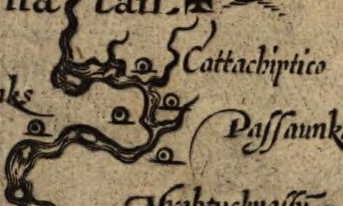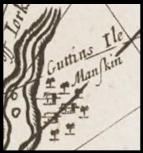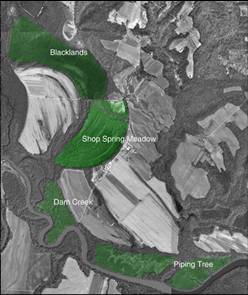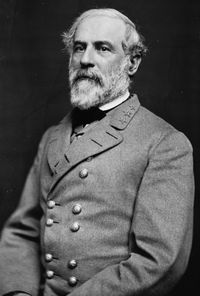— to fellow Virginian Col. Thomas H. Carter, June, 1865
(The quote above took place as Lee was leaving his first cousin's farm, Pampatike, Manquin Virginia after a visit. He was responding to a question as to whether he should use whites or blacks as laborers. The farm has been in the Townsend family for over 100 years, and is currently owned by my Cousin Frankie. Talk about a hard head! (And to think my mother thought that I had one!) I remember once he came up to us after his father, Uncle Johnny, took him into the woods for punishment, (A frequent occurrence with him!) and his legs were bleeding badly from being thrashed with branches, but Frankie said it was nothing, didn't hurt a bit! BT)
Pampatike Farm
Pampatike Farm lies along the Pamunkey River just two miles South East of the intersection of Rt. 360 and the Pamunkey River in King William County, Virginia. The Farm has a long and varied history.
 It was a Indian village called Cattachiptico and was drawn on John Smiths Map of the new world in 1609. It was then transformed into Opechancanough's fortress and newly identified documents show the possibility that it was the location where John Smith grabbed Opechancanough by the hair and put a pistol to his head in order to escape an ambush.
It was a Indian village called Cattachiptico and was drawn on John Smiths Map of the new world in 1609. It was then transformed into Opechancanough's fortress and newly identified documents show the possibility that it was the location where John Smith grabbed Opechancanough by the hair and put a pistol to his head in order to escape an ambush.
 In the 1600 through the mid 1700's, it was the location of sub-tribe of the Pamunkey Indians called the Manskin Indians who were accidentally erased from history when their name got confused with the Manakin Indians just up river.
In the 1600 through the mid 1700's, it was the location of sub-tribe of the Pamunkey Indians called the Manskin Indians who were accidentally erased from history when their name got confused with the Manakin Indians just up river.
 It was sold by the Pamunkey Indian Queen and by 1744 it became part of the the Carter Family empire. By the early 1800s, Hill Carter lived at Shirley Plantation and his brother, Thomas N. Carter lived at Pampatike. In 1820 and 30s both Hill and Thomas Carter experimented with an almost forgotten farming technology called land reclamation where the swamps were diked and corn and wheat was grown.
It was sold by the Pamunkey Indian Queen and by 1744 it became part of the the Carter Family empire. By the early 1800s, Hill Carter lived at Shirley Plantation and his brother, Thomas N. Carter lived at Pampatike. In 1820 and 30s both Hill and Thomas Carter experimented with an almost forgotten farming technology called land reclamation where the swamps were diked and corn and wheat was grown.  This was a massive transformation of the land where over 500 acres of land were reclaimed. The swamps were diked and all creeks on the property were re-routed to reduce water from the newly made "blacklands" or "meadows." The dikes were abandoned after the civil war and the land returned back to natural swamps.
This was a massive transformation of the land where over 500 acres of land were reclaimed. The swamps were diked and all creeks on the property were re-routed to reduce water from the newly made "blacklands" or "meadows." The dikes were abandoned after the civil war and the land returned back to natural swamps.
 During the Civil War Union forces camped on the property and Col. Thomas H. Carter was often visited by his first cousin General Robert E. Lee.
During the Civil War Union forces camped on the property and Col. Thomas H. Carter was often visited by his first cousin General Robert E. Lee.
No comments:
Post a Comment